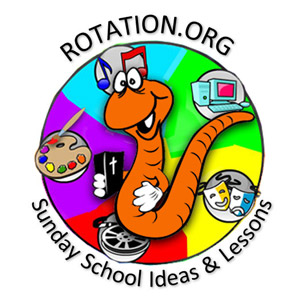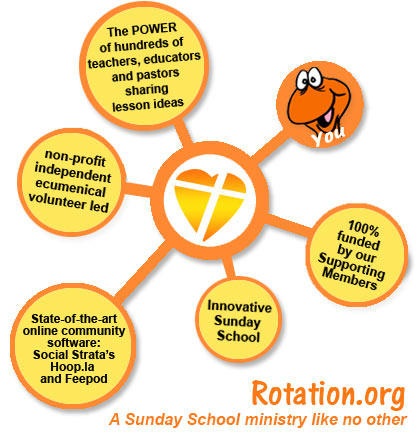Two art projects that demonstrate
how sin breaks or tears us and our relationships
and how God "restores" redeems us.
This project visually demonstrates how sin "tears" at us and leaves its mark on us, and why we need "restored." See the "alternate version" of this project at the end of this post that uses torn paper instead of glued paper and an image of Jesus to fix the restoration to.
Supplies List:
- White construction paper
- Strips of colored construction paper
- Quick drying glue sticks
- Blow dryer to hasten glue drying.
- Colored markers
*Use construction paper instead of copy paper so that the glue "tears" the paper more easily.
First, have the group brainstorm a list of sins and write them on the board as they do. As they brainstorm different sins, comment and write the "kid version" of that sin. For example, "murder" is a sin, but have them also come up with a description of how kids "kill" another person with words or hate. "Stealing" is a sin, but encourage them to think not just of "stealing a thing" but stealing someone's happiness or stealing someone's sense of safety or self worth.
Take a piece of white construction paper and have kids write their name on it in large letters. They can also add a self-portrait and words like "good," "happiness," "reputation," "loving," "trusted."
Next, give them strips of other colors of construction paper (approx 2" x 4" each). Have them write various sins they brainstormed on several strips.
Now have them glue the strips to their white "name/portrait" paper as you talk. (Glue sticks are fine, but a quick drying glue is best.)
While you give the glue a few minutes to dry (and can hasten the drying by blowing air over it)...
Read the story of Adam and Eve.
Talk about their sin, and their attempts to hide it.
How do we try to hide our sins? (Blame, hiding, lying.) Did God KNOW that Adam and Eve had sinned? Did he know where they were hiding? Why did he WAIT to come looking for them and then call out their names?
But also talk about how, by doing good things, we often to try to make up for our sin or to be good enough for God, etc.
Give each student one final strip of construction paper. Have them write the word "TRY TO HIDE MY SINS" on it and then paste it on top of all the other pasted strips of sin.
Does hiding your sins, trying to cover them up ever work? What's wrong with "hiding" your sins? God knows! God wants us to respect him and others by admitting our mistakes (confess), and seeking to put things back together (redeem, restore).
When you think the strips have "stuck enough" (by testing trying to pull one off), have students slowly tear off their "sin strips" one by one. If you let it dry long enough, this will also take off some of the white construction paper beneath it WITH the colored sin strips ---along with the words/image you drew on the white paper. This "disfiguring" of the white paper is the effect you're looking for and will now comment on. Sin "disfigures" us. It tears at us and ruins who we are meant to be.
Ask your student to explain "how the story of Adam and Eve ends." Some will think it ends with punishment, but notice that God make them clothing to cover their nakedness (their shame, their sinful selves), and then God goes with them into a difficult world.
Illustrate this point by having the students work to RESTORE their white construction paper drawing. Have them scrape off some of the glue with a craft stick or similar object and re-draw/re-letter those things which have been 'torn off" by the sin strips.
Note that we won't have a perfect looking "restorations." Sin "leaves its mark" and is not forgotten --just forgiven. We need to remember the consequences of sin to avoid sinning.
Note that "restoration" is one of the reasons we follow Jesus -- to become better people, better servants, better friends, better children and better servants to those in need.
Have each student share their "restored" drawing.
To finish the project, have the students reglue the "sin strips" to the back of the construction paper so that they have a record of what they did and learned that they can take home.
Alternate Shorter "Torn ("Broken") Paper -- Restored Paper" Version
 Instead of gluing strips of "sins" to a piece of construction paper, students will draw a self-portrait on a piece of construction paper, tear it into pieces, then restore it (using an image of Jesus
Instead of gluing strips of "sins" to a piece of construction paper, students will draw a self-portrait on a piece of construction paper, tear it into pieces, then restore it (using an image of Jesus
Have students draw a self-portrait on a piece of white construction paper, then write "positives" around their drawing, such as "trusted," "loved," "good reputation," "caring," "faithful," "unselfish." etc. Use some of the ideas brainstormed (as described above).
Then read the Adam and Eve story discussing some of the points mentioned above. Emphasize how sin "BREAKS" (tears) our relationships with each other and with God. We "lose" trust when we do things that show us to be untrustworthy. We become "broken." As you get to this "broken" part of the discussion, TEAR your self-portrait into pieces no smaller than "1" square.
Now distribute a handout with the face of Jesus on it (image attached). This will be the sheet of paper onto which students will REASSEMBLE (restore, repair, redeem) their self-portrait -- and then glue those pieces onto the image of Jesus. TIP: Only glue one corner of their torn pieces to the page with Jesus on it. This lets them lift up the pieces of their self-portrait to see Jesus underneath! 
Discuss how Jesus "restores" us --forgives, keeps being with us, doesn't abandon us. These are all things we need to do for each other as well --to take part in each other's restoration, help redeem each other, rebuilt trust, love, lives.
Attached is a printable image of Jesus from artist Richard Hook that you can print copies of and use in your art project. If you want something else, search the web.
These two projects have been updated by a member of the Rotation.org team!
If you like having great choices like these two art projects...
We are non-profit, volunteer-led, and entirely supported by donations.





















